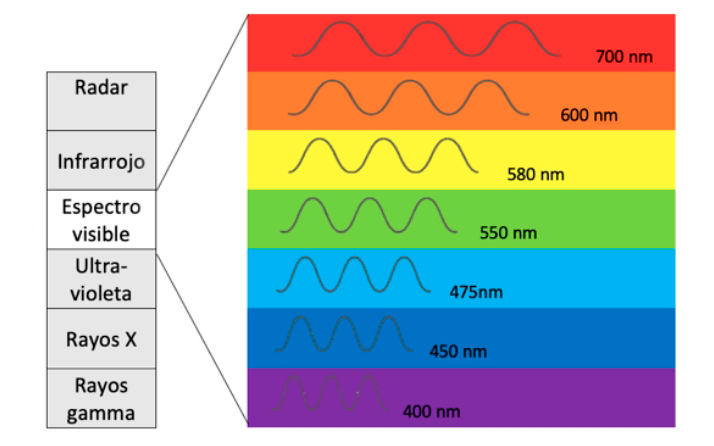
Colours are actually waves of different lengths, and the set of all the lengths we can see is known as the visible spectrum. The shortest wavelengths are what we perceive as blue, and the longest would be red, as can be seen in Figure 1.

Figure 1. The visible spectrum is the wavelengths (colours) that we can perceive. It is measured by the wavelength in nanometers (nm). In the picture, wavelengths for different types of light. From top to bottom: Radar / infrared / visible spectrum / ultraviolet / x-rays / gamma rays. / Amparo Gil Casas and María José Luque
Once the cones in our eyes transmit their response to higher areas of the brain, our visual cortex combines these responses to tell us whether a colour is red, green, yellow, or blue (the four basic tones), whether it is more or less luminous, and even whether it is very colourful or not.
Colour vision can be impaired in two ways: when there is a lack of one of these cones or when cones are present but there is an abnormality in one of them. Even though it is rare, acromatopsia has been documented. It is the lack of all three cones, which produces black and white vision.
For this reason, colourblind people see colours differently because when it comes to combining the responses of these cones in the brain, they do not have all the necessary information from the L, M and S cones. They will only have two types of cones to make this combination, thus altering their colour perception. A simile would be to try to obtain different paint colours by mixing only two primary colours: we would never be able to obtain the full range of existing colours.
Besides, not all colour-blind people see the same way, their vision will depend on which cone is altered or absent, as simulated in Figure 2. Thus, a person who lacks red cones (protanope) perceives colours as yellowish or blue; moreover, they may confuse some reds and greens, and purple with blue. If there is a lack of green cones (deuteranope), the perception is similar to protanopes because, in general, they perceive the colors as yellowish or blue, but in different colours. They also confuse greens and reds, but in this case the green colors are perceived as yellowish-brown. And finally, the absence of blue cones (tritanope) means that yellow is perceived as pink, and blue can be confused with green. On the other hand, when all the cones are present, but there is an anomaly in some of them, they maintain the perception of different tones and the effect is similar to the one described above, except that it is much lighter.

Figure 2. Simulation of vision of the different dichromats, edited with the CVSimulator app / Amparo Gil Casas and María José Luque
Alterations are most common for red and green. They are usually congenital and linked to the X chromosome, so it is manifested in men, even though the carriers are women. The alteration of the blue pigment is usually acquired by some disease such as syphilis, age-related macular degeneration (AMD), cataracts, glaucoma, or even alcohol and tobacco abuse, and it affects men and women equally.
Answered by Amparo Gil Casas, optometrist at the Optometric Clinic of the Lluís Alcanyís Foundation of the University of Valencia, and María José Luque, professor at the Departments of Optics and Optometry and Vision Sciences of the University of Valencia.
Question submitted by Aida Moreno Rus.
«Mètode’s whys and wherefores» is a science consultation office where the readers send their scientific questions and an expert answers them. You can send your question using this form. All the questions we publish between 1 July and 20 September will participate in a draw to win a selection of Mètode publications.





